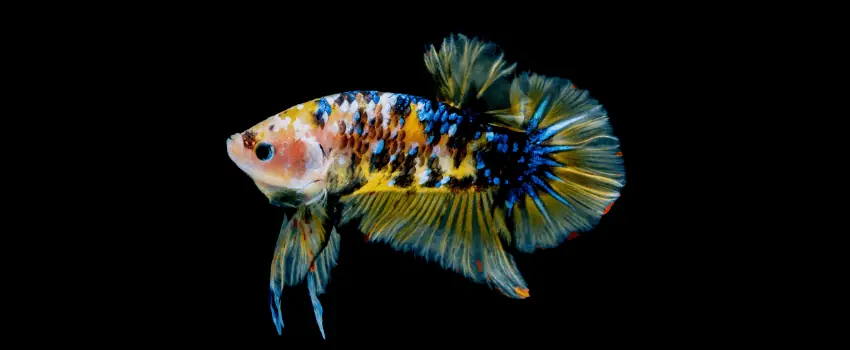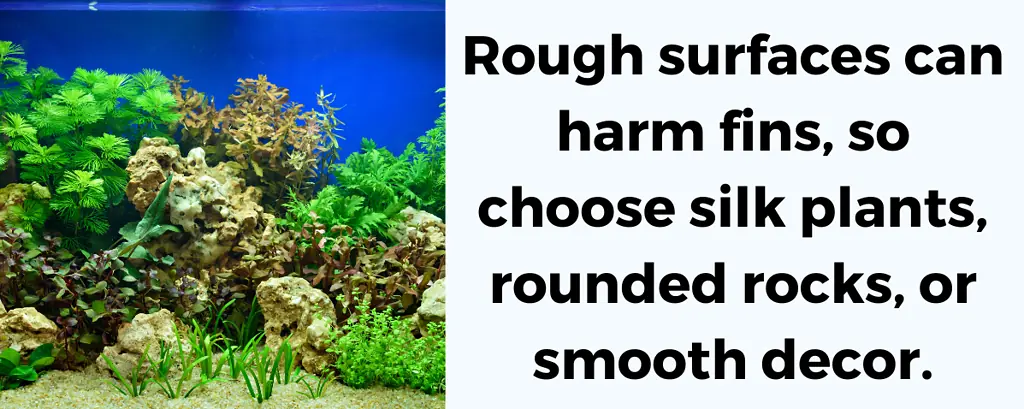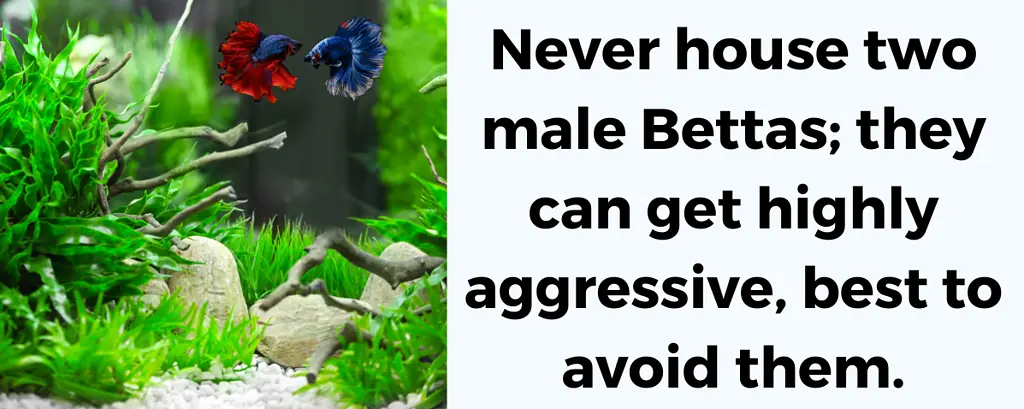Introducing the Roundtail Betta, a distinct variety within the fascinating Betta world.
Known for its broad, rounded tail, it’s like watching a resplendent swimming quarter.
Imagine a fish that could inspire watercolor artists with its colorful palette.
But wait! Although classified as “Betta fish,” each type has diverse care needs. It’s not a universal process.
Each Betta boasts its own traits and preferences, particularly concerning health.
So, let’s immerse ourselves in the Roundtail Bettas world, master their specific needs, and aim to become top-notch Betta caretakers. So get ready and dive in!
Table of Contents
Physical Characteristics of Roundtail Betta

Appearance
Shape and Size of the Fin (Tail Fin)
The Roundtail Betta stands out, thanks to the circular shape of its tail.
Instead of the sharp, spiky tails common in other Betta species, the Roundtail sports a perfect, moon-like tail fin.
Below the surface, it mesmerizes like a beautiful moon. Interestingly, specific genes are responsible for this distinctive trait.
Color Variants
Roundtail Bettas, in a stunning array of hues, brighten your aquarium with sunset reds to ocean blues.
Certain common colors, like turquoise, may be tied to genes.
In the Bettasphere, popular shades shift often; iridescent white is particularly prized.
Male vs. Female Differences

Size Differences
Roundtail Bettas are impressive in terms of size.
Typically, males reach 6.5-8 cm (2.5-3 inches), and females, slightly smaller, measure 5.5-7 cm (2-2.75 inches).
Size doesn’t significantly impact Betta care, yet larger specimens might enjoy more room.
Coloration and Fin Shape
In the aquatic world, Bettas face appearance pressures, particularly for males.
With a vibrant array of colors and ostentatious fins, male Bettas are seemingly the “fashionistas” of the deep.
What’s behind these impressive displays? Simply, sexual selection, where flashy males receive more female approval.
Behavioral Differences
Male and female Bettas show different behaviors, not just appearances.
Male Bettas are typically more aggressive, exhibiting pronounced territorial instincts.
They’re not keen on sharing their space, so pairing them with another Betta can be a tricky exercise in compatibility.
Size and Lifespan

Average Size
Typically, Roundtail Bettas measure around 6-8 cm (2.5-3 inches), a size that neither makes them the bully or the bullied of the tank.
They stand comfortably among other Betta species.
Typical Lifespan
Introducing a Roundtail Betta to your aquarium promises 3-5 years of enjoyment, provided conditions are optimal.
Lifespan hinges on factors such as diet, water quality, and stress.
Remember, clean water and quality food aren’t luxuries—they’re necessities for a Betta’s health!
Natural Habitat and Origins

Exploring Roundtail Bettas, let’s start at their original habitat. Don’t worry; no swimming is needed!
Geographic Range
Join us on an exciting adventure to Southeast Asia, the original habitat of Roundtail Bettas.
These resilient pets rule freshwater bodies, from peaceful streams and quiet rice paddies to adaptable marshlands.
Betta fish thrive with ample space—no Koi ponds, though!
Water Conditions in the Wild

Diving into the preferred water conditions of our vibrant Bettas, the crucial factors revolve around pH, temperature, and flow.
- pH: Bettas naturally exist in slightly acidic to neutral waters with a pH range of 6.0 to 7.0, illustrating their adaptability. Matching your tank’s pH to this range tailors it to their biological tendencies, providing a familiar environment.
- Temperature: The temperature sweet spot for Betta fish can be labeled as “picture-perfect”—between 75-81 degrees Fahrenheit (or 24-27 degrees Celsius for metric users). This comforting warmth not only coddles them but also boosts their active temperament. Sustaining this temperature can make your Betta as lively as a sparkler at a celebration.
- Flow: Adventurous Bettas appreciate calm, almost stationary waters. Hence, create a tranquil environment with scarce flow in your aquarium, offering them a homely experience, enough to make them sigh, “Feels just like home.”
Understanding a Betta’s preference and natural habitat allows us to replicate bubbles of pure joy.
Care Requirements for Roundtail Betta

General Tank Requirements for All Bettas
Betta enthusiasts understand that the right tank setup is crucial for a blissful, flourishing fish.
This is especially important for the captivating Roundtail variety.
All types of Betta, from vibrant Veiltails to regal Roundtails, need a tank with at least a 5-gallon capacity.
Though small tanks and bowls may seem desirable, they seldom grant our aquatic royals the room they crave.
Bettas are little explorers, needing ample space to feel secure and explore.
But a sizable tank isn’t the be-all and end-all.
A top-quality filtration system and proper aeration are also mandatory for a thriving Betta environment.
The filtration setup works as a dedicated cleaner, ridding the water of harmful substances to maintain purity.
Aeration, meanwhile, acts like our necessity for fresh air, providing vital oxygen for the fish.
Offering these essentials guarantees a life-sustaining haven for your Betta.
Specific Tank Requirements for Roundtail Betta

Now, let’s dip into the specifics for making your Roundtail Betta rounds of joy.
Ideal Tank Size
While beautiful, the distinct fins of Roundtail Bettas hinder their swimming prowess.
With a taste for brevity in motion, they favor smaller, 5-gallon tanks, easy to explore yet spacious enough for swimming.
Recommended Decor and Substrate
For Roundtail Betta décor and substrate, remember: ‘smooth is safe.’
Rough surfaces can injure their delicate fins, hindering their graceful swim.
Silk plants, rounded rocks, or smooth cave-style décor are best.
Choose either petite, smooth pebbles or sand as a substrate.
Diet and Nutrition

Forget diamonds – good food is a Betta’s best friend!
Types of Food
Though we adore a mishmash of burgers, pizza, and rare salads, Roundtail Bettas have a distinct taste.
Nutrient-rich pellets are their dietary staple.
Flakes can enhance their nutrition, but live food is a real treat.
They love Daphnia, brine shrimp, and bloodworms.
This live feeding triggers instincts, boosting their color and health due to their high protein content.
Enjoyment ensues – bonus!
Feeding Schedule
Size doesn’t equate to appetite in Roundtail Bettas.
They might be small, but they can eat like a teenager if left unchecked, which can cause bloating.
Feed them twice daily, usually 3-4 pellets each feeding.
Faster-growing juveniles may require more meals.
Health Considerations

Common Diseases
Although Roundtail Bettas are generally hearty, they can succumb to common fish ailments such as Fin Rot, Velvet, or Ich.
Signs include clamped fins, low appetite, lethargy, or color changes.
Prioritizing pristine water conditions primarily prevents these issues.
Preventive Care
Like an apple a day keeps the doctor away, clean water does the same for your fish!
Regular water changes, ideal temperature, pH balance, and judicious use of conditioners constitute preventative care.
Don’t forget to occasionally examine your fish for signs of trouble.
After all, happy fish leads to a blissful aquarium!
Behavior and Temperament

General Behavioral Traits
Roundtail Bettas, our little aquatic artists, don’t just brighten aquariums; they add personality, too.
Esteemed for their fearlessness, it’s tough to find a Betta fish backing down from a confrontation.
This boldness translates into mild aggression, particularly with other males.
Did you know when Bettas puff their gills, it’s their equivalent to our gym flex-off?
An aquatic show of strength that’s quite the spectacle!
But their lives aren’t all about flexing. Despite their brawn, they’re also brainy and quickly grow bored.
So, make sure their environment stays exciting!
Like a reclusive poet or novelist, Roundtail Bettas cherishes solitude over the company.
They prefer their quiet world to a rowdy crowd.
Social Dynamics with Tank Mates

Bettas are solitary by nature – they don’t thrive in a crowded tank.
The most important rule for Betta ownership?
Never house two males together – they can become aggressively combative. It’s a scenario no one wishes to witness.
Bettas can occasionally cohabit with other non-aggressive fish species that don’t mimic their appearance.
Beware, vibrant fish might invoke jealousy, sparking competition – something no one cherishes.
Witnessing signs of stress like faded color, clamped fins, or reduced appetite can indicate problematic interspecies relations.
Show responsibility: consider revisiting your tank’s composition when noticing these signs.
Your aquatic citizens’ peace hinges upon this!
Compatibility and Tank Mates

Good Tank Mates
Roundtail Betta fish, celebrated for their colorful palettes and flowy tails, thrive best with select tank companions.
Given their territorial tendencies, finding ideal aquatic friends to join their habitat is pivotal.
Here are a few creatures that can harmoniously live with Roundtail Bettas.
- Harlequin Rasbora: These peace-loving swimmers make excellent roommates for Roundtail Bettas, staying away from Betta-preferred bottom spots in the tank’s upper or middle levels. They’ve truly mastered peaceful coexistence.
- Ghost Shrimp: As natural ‘invisibility cloak’ wearers, their transparency keeps them hidden from Bettas’ attention, fostering peaceful cohabitation. Plus, they are thorough tank cleaners, a quality everyone cherishes in a roommate!
- Mystery Snail: Betta fish interestingly fail to recognize Mystery Snails as living beings, assuming they’re moving decorations. This convenient ignorance means snails and Bettas live together without issue.
- Ember Tetra: These quick, small, luminous fish stay out of Betta’s way, maintaining peace by staying in their speedy flow, which Roundtail Bettas appreciate!
Species to Avoid

Let’s explore the flip side: aquatic species to avoid.
Certain underwater dwellers could make a Roundtail Betta’s life about as amusing as a terrestrial existence without air!
- Fancy Guppies: Their vibrant, large tails may invite unwanted attention from Bettas, who confuse them for rivals. Misunderstanding and territorial instincts stir up trouble, making for a turbulent tank.
- Tiger Barbs: Notorious troublemakers, they nib at Betta’s splendid tail fin, causing relentless stress. They’re essentially the neighborhood thugs of the betta universe.
- Red-Tailed Shark: Too bulky for a Betta’s comfort and territorial. Coupled with Betta’s similar traits, a scenario akin to underwater West Side Story could unravel…
Choose the right tank buddies, and your Betta’s environment can echo a dolphin choir’s harmony.
Introduce new friends slowly, armed with a backup plan – just in case.
Breeding

Required Conditions
Embarking on a Roundtail Betta breeding journey can be thrilling.
Before donning your figurative lab coat, let’s discuss the ideal environment for these aquatic star-crossed lovers.
Comfort is essential for breeding, highlighting the importance of ideal tank setup and conditions.
The breeding tank should be shallow, 5 to 10 gallons, filled to roughly 5 to 6 inches.
Roundtail Bettas build bubble nests at the water’s surface, so they’d rather not scale a mountain to reach their home.
Keep the water at a snug 80°F, with a pH between 6.5 and 7.
Bettas relish slightly acidic conditions. If feasible, soften the water.
As the tough guys of the fish world, they fancy the gentlest water!
Include leaf litter, especially Indian Almond leaves – my personal “Love Leafs.”
They give a natural vibe and protect eggs with antibacterial properties, aiding bubble nest construction.
Bettas cherish privacy, so consider small plants and caves for concealment.
Dim your lighting – nobody appreciates a mood-ruining bright light, right?
With your tank set and oozing romance (like my pun?), introduce male and female bettas cautiously – they’re hardly love-at-first-sight types.
Common Challenges

Becoming a betta fish caregiver isn’t all smooth sailing; there are some waves to ride out.
Even fish can get feisty in the face of romance. Consider separating your bettas with a divider when they first meet to prevent aggression.
This lets them peek at each other without the risk of harm.
Once they have snapped enough longing glances, you may remove the barrier.
Egg-binding, causing bloating in females, is another common issue.
To stave this off, keep your female well-nourished pre-mating.
In case she seems distressed, a swift vet visit should settle things. There’s no need for panic.
Know that while hiccups may occur, there’s always a solution at hand.
There’s a unique joy in watching your little bettas zoom around.
With strategic planning and attentive care – a touch of under-the-sea telepathy helps – breeding Roundtail Bettas can be a success.
Believe me, it’s bubble-bursting fun!
Cost and Availability

In the realm of Roundtail Bettas, several elements impact their cost and availability.
Grasping these can equip you for an exciting adventure into this world of elegant, finned marvels.
Pricing Factors
What is the cost of owning a Roundtail Betta? Let’s delve into factors influencing their price:
- Color Rarity: Unique colors are popular among betta breeders. Bettas in rare or brightly colored hues may fetch higher prices. Fancy a neon green betta with a shimmer of blue specks? Expect to pay more.
- Fin Quality: A Roundtail Betta’s standout feature is its unique fin form. A healthy, gracefully curved fin is sought-after, meaning more impressive fins equate to a heavier price tag.
- Age: Young bettas are less pricey than mature ones. Their striking colors and developed personalities make older bettas attractive to aquarists.
- Breeder Reputation: Reputable breeders known for quality, robust bettas will charge more. With any purchase, you usually pay for quality and assurance.
Remember, these prices have room for flexibility, influenced by market demand, location, and more.
It resembles predicting the weather: part science, part good old guessing.
Availability and Where to Buy
Scoring quality Roundtail Bettas isn’t as straightforward as nabbing the prettiest pet store specimen.
Use these tips to reel in that perfect aquatic pet:
- Local Pet Stores: Aquatic-focused pet stores might harbor a decent Roundtail Bettas selection. Make sure they’re up to snuff with their fish-care protocols.
- Aquarium Shows or Expos: These events often flaunt a broader betta portfolio, offering unique prizes worth the price of admission.
- Online Breeder Direct: Purchasing from breeders can offer healthy, well-bred bettas. Many esteemed breeders flaunt their finest fish online.
Ensure to sidestep sources falling short on fish care, opting for responsible betta adoption instead.
Vote with your wallet, bolstering groups dedicated to nurturing healthy bettas.
Remember, acquiring a Roundtail Betta, or any pet, shouldn’t be taken lightly.
Their monetary cost barely scratches the surface.
True expenses include their upkeep, diet, and healthcare, plus your invested time and care.
Frequently Asked Questions

Are roundtail bettas rare?
While roundtail bettas aren’t as common as the veiltail or crowntail types, they aren’t rare.
They appear regularly in pet stores and among betta breeders.
They might appear elusive due to their subtly distinctive tail shape. So, owning one feels like entry into an exclusive club!
Are roundtail betta fish more aggressive than other betta types?
Roundtails share the same “fighting fish” spirit as other bettas.
However, their aggression isn’t due to their tail shape but is tied to individual temperament and territorial instinct.
If you are seeking a relaxed fish, consider other options. Don’t forget, though, their feisty nature adds charm!
Are roundtail bettas more difficult to care for?
Caring for roundtail bettas isn’t particularly challenging.
They need warm water, ample tank space, a balanced diet, and mental stimulation, like any other betta type.
Having multiple bettas doesn’t make you an expert, so consult a reliable source before housing a roundtail betta.
Prevention is key when dealing with aquatic pals.


